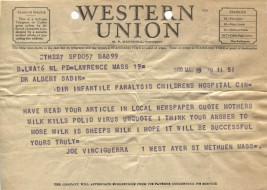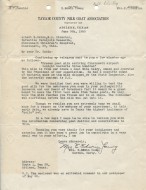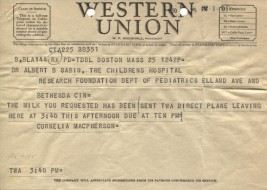In May 1950, at the sixtieth annual meeting of the American Pediatric Society, Dr. Sabin reported that he had discovered an “Antipoliomyelitic Substance in Milk of Human Beings and Certain Cows.”[1] Although Dr. Sabin was cautious to say that research was still needed to determine what the substance was and how it could be useful, the popular press picked up on the report with headlines such as:
“Mother’s Milk Has Anti-Polio Substance,” Science Service, 16 May 1950
“Researcher Seeking Factor in Milk to Prevent Paralysis in Polio Cases,” Cincinnati Times-Star, 19 May 1950
“Anti-Polio Human Milk,” Science News Letter, 27 May 1950
This information even appeared in the May 29, 1950 issue of Time magazine. Due to the the large amount of publicity that this report received, Dr. Sabin accumulated letters from researchers and other interested parties. The information contained in these letters ranged from encouragement to suggestions for further research. For example, Dr. Sabin received several letters suggesting that he test goat’s milk for the same substance. Others provided suggestions as to what the mystery substance might be. Another example appears in the telegram seen to the left, in which Mr. Vinciguerra suggests testing sheep’s milk.[2]
What I found extremely interesting in this part of the collection were the amount of people willing to help Dr. Sabin’s polio research by sending him milk. One example seen to the right is from Mrs. E. Edwin Young, who not only sent Dr. Sabin goat’s milk for research, but later on sent goat’s blood for the same purpose. In a January 9, 1950 letter to Dr. Sabin, Mrs. Young wrote, “The members of the [Taylor County Milk Goat] Association are getting a good deal of happiness out of helping out in this project. I guess it is good when we feel we can participate in the undertakings that just might be of some use to the human family.”[3]
Not only do we have correspondence pertaining to goat’s milk, but we also have correspondence regarding human milk for experimental purposes. Dr. Sabin and Dr. Clement A. Smith had previously spoken at a meeting about potential organizations that might be willing to donate human milk for polio research. In June 1950, Dr. Smith wrote, “In answer to your letter of May twenty-ninth, I have sounded out the administrative staff of the Directory for Mothers’ Milk and find them quite willing to supply milk for research purposes in the general amounts indicated.”[4] The telegram seen below is from Cornelia MacPherson of the Directory for Mothers’ Milk, indicating that the milk would arrive at 10:00pm in Cincinnati.[5]
I think the huge response that Dr. Sabin received due to his report on the “antipoliomyelitic substance in milk” goes to show how much of an impact polio had on lives during this period. People were willing to reach out to Dr. Sabin in hopes that they could help children avoid this dreaded disease. And in many cases, Dr. Sabin was willing to listen to their ideas and respond to their letters.
References
[1] See American Journal of Diseases of Children 1950, volume 80, issue 5, pages 866-67 for more information.
[2] Telegram from Mr. Joe Vinciguerra to Dr. Sabin, 19 May 1950. Found in Series 9 Poliomyelitis, Sub-Series Correspondence, Box 4, Folder 7 – Anti-Poliomyelitis Substance in Milk, Lay Correspondence, 1950-1952.
[3] Letter from Mrs. E. Edwin Young to Dr. Sabin, 9 January 1951. Found in Series 9 Poliomyelitis, Sub-Series Correspondence, Box 4, Folder 6 – Anti-Poliomyelitis Substance in Milk, 1950-1951.
[4] Letter from Dr. Smith to Dr. Sabin, 5 June 1950. Found in Series 9 Poliomyelitis, Sub-Series Correspondence, Box 4, Folder 6 – Anti-Poliomyelitis Substance in Milk, 1950-1951.
[5] Telegram from Miss Cornelia MacPherson to Dr. Sabin, July 1950. Found in Series 9 Poliomyelitis, Sub-Series Correspondence, Box 4, Folder 6 – Anti-Poliomyelitis Substance in Milk, 1950-1951.
In 2010, the University of Cincinnati Libraries received a $314,258 grant from the National Endowment for the Humanities (NEH) to digitize the correspondence and photographs of Dr. Albert B. Sabin. This digitization project has been designated a NEH “We the People” project, an initiative to encourage and strengthen the teaching, study, and understanding of American history and culture through the support of projects that explore significant events and themes in our nation’s history and culture and that advance knowledge of the principles that define America. Any views, findings, conclusions, or recommendations expressed in this blog do not necessarily reflect those of the National Endowment for the Humanities.



